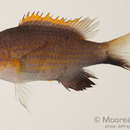Diagnostic Description
provided by Fishbase
Color is alternating blue and yellow stripes. The caudal fin has a broad yellow upper lobe margin and a broad black lower lobe margin. The margin of the spinous portion of the dorsal fin is also yellow; the anal fin is largely black.
Life Cycle
provided by Fishbase
Oviparous, distinct pairing during breeding (Ref. 205). Eggs are demersal and adhere to the substrate (Ref. 205). Males guard and aerate the eggs (Ref. 205).
Morphology
provided by Fishbase
Dorsal spines (total): 12; Dorsal soft rays (total): 10 - 12; Analspines: 2; Analsoft rays: 10 - 12
Trophic Strategy
provided by Fishbase
Occurs in small to large aggregations in exposed outer reef slopes and rocky inshore reefs. Its diet consists of zooplankton, especially copepods (Ref. 3921). Diurnal species (Ref. 54980; 113699).
Biology
provided by Fishbase
Adults occur in small to large aggregations in exposed outer reef slopes and rocky inshore reefs (Ref. 3921). Benthopelagic (Ref. 58302). Diet consists of zooplankton, especially copepods (Ref. 3921). Oviparous, distinct pairing during breeding (Ref. 205). Eggs are demersal and adhere to the substrate (Ref. 205). Males guard and aerate the eggs (Ref. 205). Diurnal species (Ref. 54980; 113699).
- Recorder
- Estelita Emily Capuli
Importance
provided by Fishbase
aquarium: commercial
- Recorder
- Estelita Emily Capuli
分布
provided by The Fish Database of Taiwan
分布於中西太平洋區,東起台灣,西至夏威夷及皮特凱恩群島,北至伊豆島,南至羅雷淺灘、羅得豪島及拉帕群島。台灣主要分布於南部、綠島和蘭嶼等海域。
利用
provided by The Fish Database of Taiwan
小型之雀鯛,無食用價值。有人將其作觀賞魚之用。
描述
provided by The Fish Database of Taiwan
體呈橢圓形而側扁,標準體長為體高之
2.3-2.7倍。吻圓鈍。眼中大,上側位。口小,上頜骨末端僅及眼前緣;齒細小,圓錐狀。眶下骨裸出;前鰓蓋骨後緣平滑。體被大櫛鱗;側線之有孔鱗片16-18個。背鰭單一,軟條部不延長而略呈角形,硬棘XII,軟條10-12;臀鰭硬棘II,軟條10-12;胸鰭鰭條16-18;尾鰭叉形,上下葉末端呈尖形,各具2條硬棘狀鰭條。體側及頭部為藍色與黃色交互的斑紋;尾鰭有一個寬的黃色上葉邊緣與寬的黑色下葉邊緣;背鰭硬棘部的邊緣黃色;
臀鰭大半為黑色。
棲地
provided by The Fish Database of Taiwan
主要棲息於裸露的外礁斜坡與近海岩礁中,成小群到大群活動,棲息深度在2-20公尺間。
主要以浮游動物為食,尤其橈腳類的動物。
Pycnochromis vanderbilti
provided by wikipedia EN
- license
- cc-by-sa-3.0
- copyright
- Wikipedia authors and editors
Pycnochromis vanderbilti: Brief Summary
provided by wikipedia EN
Pycnochromis vanderbilti, commonly known as Vanderbilt's chromis, is a species of damselfish native to the Indian Ocean and the Pacific Ocean. The specific name honours the yachtsman and explorer George Washington Vanderbilt III (1914-1961), the organiser of an expedition to Oahu in 1940 during which the type was collected. In naming this species Fowler acknowledged Vanderbilt for his role in developing the collection of fishes at the Academy of Natural Sciences of Philadelphia.
- license
- cc-by-sa-3.0
- copyright
- Wikipedia authors and editors

